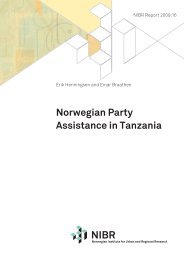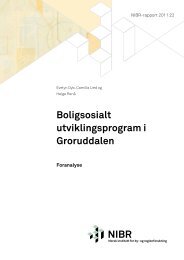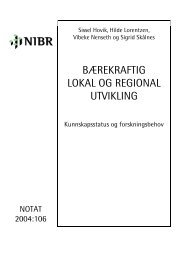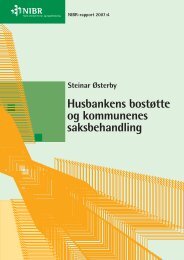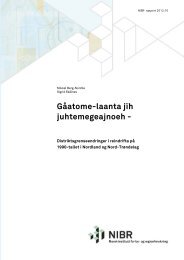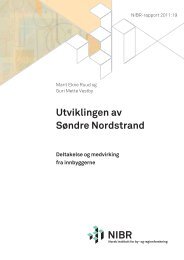http://www.tandfonline.com/page/terms-andconditions
The special importance of housing policy for ethnic minorities ...
The special importance of housing policy for ethnic minorities ...
- No tags were found...
You also want an ePaper? Increase the reach of your titles
YUMPU automatically turns print PDFs into web optimized ePapers that Google loves.
18 H. Skifter Andersen et al.Downloaded by [Norsk Institutt for By og] at 07:07 11 March 2013A large social/public housing sector, such as that found in Denmark and, before 2000,in Sweden, paves the way for good housing opportunities for immigrants. Open accessto social/public housing for all in<strong>com</strong>e groups increases immigrants’ housing options.However, the lessons from Finland are that if housing policy is concentrated on support forhousing for the poor, who are housed in social/public housing allocated strictly on the basisof need, immigrants tend to be very concentrated in this kind of housing. Also, in Denmarkthere is a high concentration of immigrants in social/public housing. This can partly beexplained by a housing policy that in general has resulted in higher-in<strong>com</strong>e segmentationon the housing market than in Sweden and Finland. The universalistic housing policy inSweden of giving equal status to all tenures has resulted in a modest ethnic segmentationof the housing market and in a smaller over-representation of immigrants in social/publichousing. It has also resulted in smaller differences between immigrants and the nativepopulation concerning overcrowding.The high over-representation of immigrants in social/public housing in Denmark andFinland has led to spatial segregation and to a high concentration of immigrants appearingin certain neighbourhoods in the cities. It can be assumed that processes of ethnic spatialsegregation such as ‘preferences for enclaves’ and ‘white flight and avoidance’ have occurredin these neighbourhoods and thus have contributed to increased over-representationin social/public housing. Also, in Sweden large housing estates with high concentrationsof immigrants exist where these processes may have occurred. In Norway, concentrationsof immigrants have mostly occurred in neighbourhoods with cooperatives. But it doesnot seem that these immigrant-dense neighbourhoods in Norway and Sweden have to thesame extent contributed to a concentration of immigrants in respectively cooperatives andsocial/public housing.AcknowledgementsThis article was developed as a part of the NODES project (Nordic welfare states andthe dynamics and effects of ethnic residential segregation <strong>http</strong>://blogs.helsinki.fi/nodesproject/)financed by NORFACE. It is based on material from a report <strong>com</strong>paring four countries (Anderssonet al., 2010) and a special paper on housing policies (Skifter Andersen, 2012). It will be followedby another article illuminating the consequences for segregation in the four capitals.The description of Finnish housing policy is based on a section in Andersson et al. (2010) written bySaara Yousfi, Katja Vilkama, and Mari Vaattovaara, University of Helsinki. Katja Vilkama has alsocontributed with <strong>com</strong>ments to this article and some data. Furthermore Rolf Barlinghaug, NorwegianInstitute for Urban and Regional Research has contributed with some Norwegian data.ReferencesAalbers, M. B. (2002). The neglected evidence of housing market discrimination in the Netherlands.Radical Statistics Journal, 79/80, 161–169.Alba, R., & Nee, V. (1997). Rethinking assimilation theory for a new era of immigration. InternationalMigration Review, 31, 826–874.Andersson, R. (1998). Socio-spatial dynamics: Ethnic divisions of mobility and housing in post-PalmeSweden. Urban Studies, 35, 397–428.Andersson, R., Dhalmann, H., Holmquist, E., Kauppinen, T. M., Turner, L. M., Skifter Andersen,H., ... Yousfi, S. (2010). Immigration, housing and segregation in the Nordic welfare states.Helsinki: Department of Geosciences and Geography, University of Helsinki.Artle, R., & Varaiya, P. (1978). Life cycle consumption and homeownership. Journal of EconomicTheory, 18, 38–58.Bengtsson, B., Annaniassen, E., Jensen, L., Ruonnavaara, H., & Sveinsson, J. R. (2006). Varför såolika? Nordisk bostadspolitik i jämförande historisk ljus.Malmö: Egalitè.



